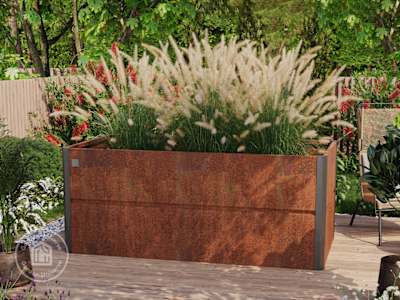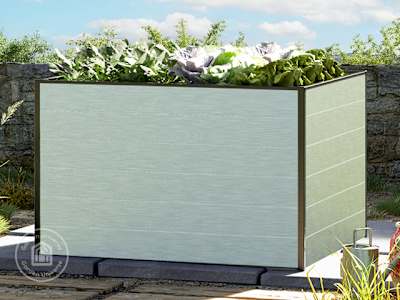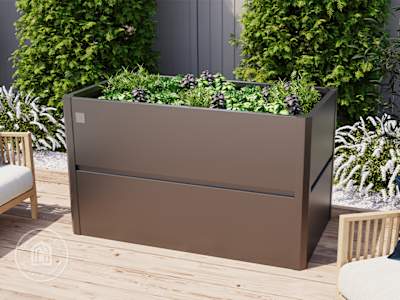Raised Garden Bed Buying Guide
Thinking about buying a raised bed garden? Whether you’re a first-time grower or a seasoned gardener looking to upgrade your setup, choosing the right raised garden bed can make all the difference. From materials and sizes to durability and design, there’s a lot to consider before you dig in.
In this guide, we’ll walk you through everything you need to know—from understanding capacity and layout to comparing materials like Corten steel, galvanized steel, and aluminum. Our goal? To help you find the perfect raised bed for your space, your crops, and your gardening style.
Let’s grow something great—together!
What are Good Materials to Build Raised Garden Beds?
The appropriate material for your raised garden bed is essential for its durability, functionality, and aesthetic appeal. Metal options, such as aluminum, galvanized steel, and corten steel, offer distinct advantages.
For Gardeners Seeking Alternative Materials
Plastic Containers
Utilizing plastic containers for raised beds is an affordable and lightweight option. However, they may lack the durability of metal or wood and can degrade over time due to UV exposure.
Wood
Natural wood like cedar and redwood are popular due to their natural rot resistance and aesthetic appeal. Cedar, in particular, is durable and contains natural oils that deter pests, making it one of the best woods for building raised garden beds.
Cinder Blocks and Bricks
Building raised beds with cinder blocks or bricks offers a sturdy and cost-effective solution. These materials are durable and allow for flexible design shapes. However, they can be heavy and may require more effort to install.
Volume Capacity Guide
| Product Variant | Height (ft) | Width (ft) | Length (ft) | Volume in Cubic Feet | Volume in Gallons |
|---|---|---|---|---|---|
| Small Beds (Under 200 Gallons) | |||||
| HALFSIZE Half-Height | 1.28 | 2.5 | 4.9 | 16 cu ft | 118 gal |
| HALFSIZE Half-Height | 1.28 | 3.2 | 3.9 | 16 cu ft | 120 gal |
| HALFSIZE Half-Height | 1.15 | 2.46 | 5.91 | 17 cu ft | 126 gal |
| HALFSIZE Half-Height | 1.28 | 3.9 | 3.9 | 20 cu ft | 146 gal |
| HALFSIZE Half-Height | 1.28 | 3.2 | 4.9 | 21 cu ft | 151 gal |
| HALFSIZE Half-Height | 1.28 | 2.5 | 6.4 | 21 cu ft | 154 gal |
| HALFSIZE Half-Height | 1.28 | 3.9 | 4.9 | 25 cu ft | 183 gal |
| HALFSIZE Half-Height | 1.28 | 3.2 | 6.4 | 27 cu ft | 197 gal |
| Medium Beds (200-400 Gallons) | |||||
| CHRISTINA Standard | 2.53 | 2.53 | 4.92 | 32 cu ft | 236 gal |
| HALFSIZE Half-Height | 1.28 | 3.9 | 6.4 | 33 cu ft | 239 gal |
| CHRISTINA Standard | 2.53 | 3.25 | 3.9 | 33 cu ft | 240 gal |
| THEO Design | 2.53 | 2.79 | 4.92 | 35 cu ft | 260 gal |
| CHRISTINA Standard | 2.53 | 3.9 | 3.9 | 39 cu ft | 288 gal |
| CHRISTINA Standard | 2.53 | 3.25 | 4.92 | 41 cu ft | 303 gal |
| CHRISTINA Standard | 2.53 | 2.53 | 6.4 | 41 cu ft | 307 gal |
| THEO Design | 2.53 | 2.8 | 6.56 | 47 cu ft | 348 gal |
| NELE Design | 2.53 | 2.8 | 6.56 | 47 cu ft | 348 gal |
| CHRISTINA Standard | 2.53 | 3.9 | 4.92 | 49 cu ft | 364 gal |
| DANIELA Kingsize | 2.53 | 2.53 | 7.7 | 50 cu ft | 369 gal |
| CHRISTINA Standard | 2.53 | 3.25 | 6.4 | 53 cu ft | 394 gal |
| Large Beds (400 + Gallons) | |||||
| ECO Standard | 2.53 | 3.25 | 6.53 | 54 cu ft | 402 gal |
| NELE Design | 2.53 | 3.28 | 6.56 | 55 cu ft | 408 gal |
| THEO Design | 2.53 | 3.28 | 6.56 | 55 cu ft | 408 gal |
| DANIELA Kingsize | 2.53 | 2.53 | 9.74 | 63 cu ft | 467 gal |
| CHRISTINA Standard | 2.53 | 3.9 | 6.4 | 64 cu ft | 473 gal |
| DANIELA Kingsize | 2.53 | 2.53 | 11.52 | 74 cu ft | 552 gal |
Wondering how much soil you’ll need?
Discover the best way to fill your raised bed—from bottom layer to topsoil. Learn soil mix ratios, layering techniques, and how to calculate the right amount of soil.



